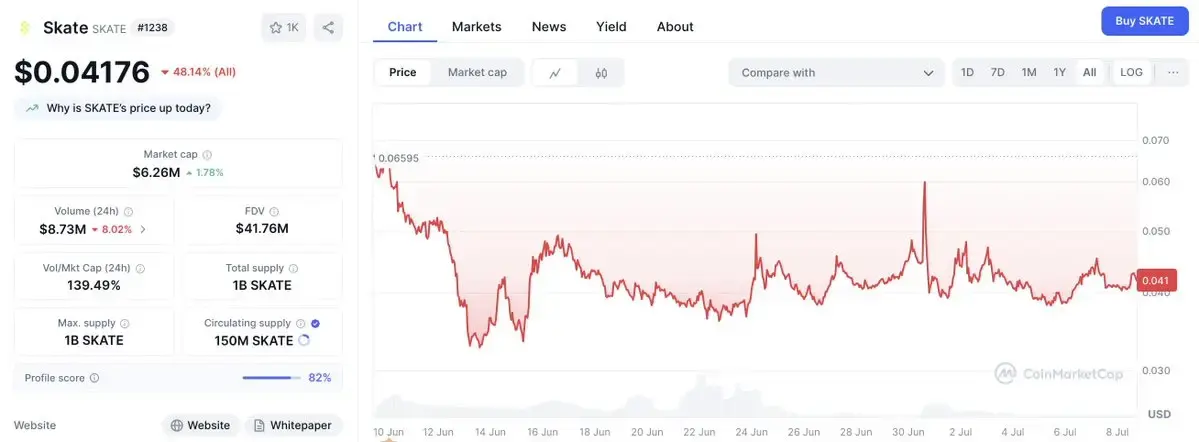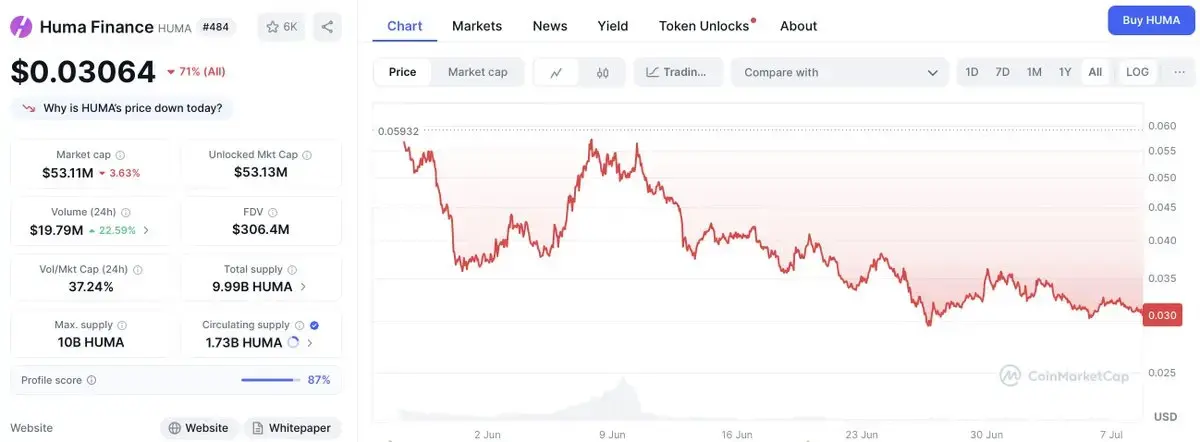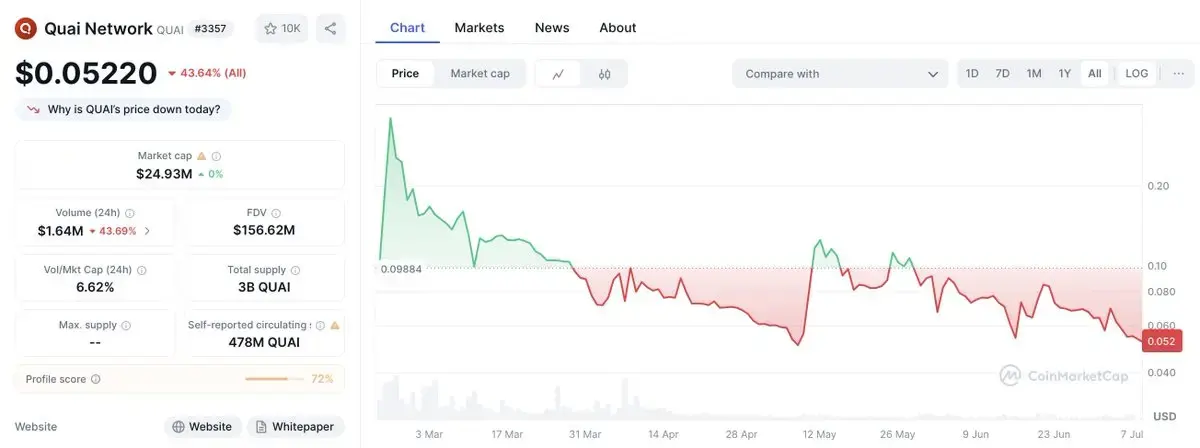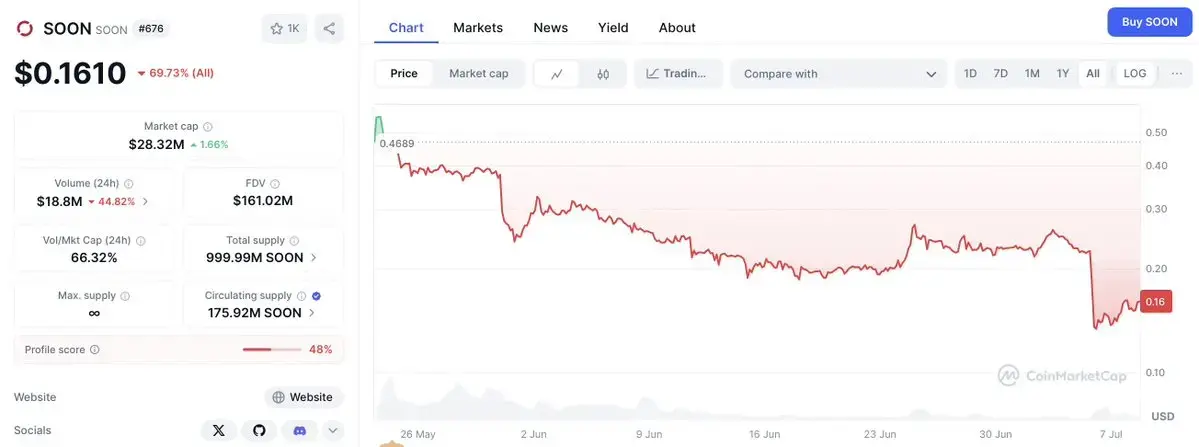Author: Stacy Muur
Translation: Felix, PANews
The crypto market has always been driven by narratives. However, in 2025, a new attention-grabbing mechanism took center stage: the KaitoAI Earn leaderboard. These incentive activities reward early researchers, commentators, and meme creators (commonly known as "yappers") for generating hype before a project launches, in exchange for future token allocations.
The operational model is now well-known:
- Reward early user recognition
- Fabricate stories
- Create demand before TGE
It does work. Leaderboards can enhance visibility, trading volume, and social validation. But the question is:
Can this attention be sustained?
Once token distributions and airdrops are claimed, those "noisy" players will shift to the next token launch. Prices drop, trading volumes shrink, and participation gradually declines.
This article critically analyzes several Kaito-related projects, including $SKATE, $HUMA, $QUAI, and $SOON, to explore whether this hype can be sustained after token launches. A trend is emerging: narratives are designed to attract attention rather than maintain it.
Let's start with SKATE.
Skate: High Trading Volume, Numerous Listings, and Stagnation Post-Kaito
$SKATE is a token associated with the Solana modular gaming layer, which launched with strong momentum. With support from well-known exchanges like Binance and Bitget, along with an extensively promoted Kaito Earn campaign, SKATE had ample liquidity and high visibility at launch.
- TGE: June 10, 2025
- Issue Price (Opening Price): $0.06506
- First Day Closing Price: $0.05094
- First Day Trading Volume: $41.46 million
- Initial FDV: Approximately $65 million
- Current Price (July 7): $0.04065
- Current FDV: Approximately $40.65 million
- Post-TGE Decline: Approximately 37.5%
- Current 24-Hour Trading Volume: $8.46 million
- Trading Volume / MC Ratio (July 7): Approximately 139%

Early trading of SKATE showed a good start. On June 10, the token's attention surged, with the price briefly spiking to $0.06539, but then quickly retracing to around $0.05094, resulting in a roughly 22% pullback on the first day.
Subsequently, other projects under Kaito also exhibited similar trends upon launch:
- Mid-June: Supported by post-listing momentum, the price rebounded to between $0.051 and $0.048 (June 11 to 16).
- June 21 to 23: Trading volume fluctuated significantly (daily trading volume around $110 million), but lacked a strong directional trend.
- June 30 to July 4: Experienced brief volatility, spiking to $0.06234 before quickly declining.
- July 5 to 7: Price fell back to $0.04065, down about 37% since TGE, and down about 22% from the peak on July 4.
Social buzz also peaked early but then quickly declined. Within 7 to 10 days post-launch, Kaito contributors shifted their attention to new leaderboard projects and token activities, leading to a noticeable drop in mentions and participation.
Summary: Rotation Over Retention
SKATE had all the favorable conditions: listing on major CEXs, high liquidity, and a reward-driven Kaito ecosystem narrative. However, SKATE's attention did not last. Despite SKATE's daily trading volume nearing 140% of its market cap, it remains a high-turnover asset with no long-term holders.
The story of SKATE mirrors that of other tokens in the Kaito Earn ecosystem:
- Pre-launch hype
- Immediate trading volume spike post-launch
- Airdrop claims and quick exits
- Narrative exhaustion within weeks
SKATE's market performance further corroborates the criticisms leveled at projects driven by Kaito: high visibility, low user stickiness.
Huma: Launchpool Hype, Kaito Rewards 0.5%, First Day Rotation Amount Reaches $300 Million
Huma is a decentralized payment financing protocol (PayFi) that utilized the complete tech stack of Binance and Kaito, launching its native token HUMA on May 26, 2025.
The Binance Launchpool activity allowed users to mine HUMA by staking BNB, FDUSD, or USDC from May 23 to 26. At the same time, Huma also launched a Kaito Earn activity, distributing 0.5% of the total supply across three "Seasons."
First Season Distribution:
- 0.1% allocated to the top 500 participants on the Kaito leaderboard
- 0.1% allocated to contributors in Solana, DeFi, and RWA categories
- Allocations to those registered via SOL wallets and Kaito ecosystem token holders
Trading began on Binance at 21:00 (UTC+8) on May 26. As of May 27:
- TGE (Opening Price): $0.06683
- First Day Closing Price: $0.05936
- Opening Pullback: Approximately 11.2%
- First Day Trading Volume: $310.37 million
- First Day Market Cap: $102.89 million
- Current Price (July 7): $0.03083
- Current Market Cap: $53.44 million
- FDV: $308.6 million
- Trading Volume / Market Cap Ratio (July 7): ~33%
Despite the hype from Launchpool and Kaito Earn, most of HUMA's trading was rotational. First season rewards could be claimed from day one, and the second season was already announced, leading to increased selling pressure rather than long-term holding.

After briefly stabilizing around $0.05 in early June, the price continued to decline over the next month, dropping 40% from June 9 to July 7. This trend reflects not only profit-taking but also a lack of sustained demand. Daily trading volume shrank by over 90% from the first day's peak, and the gap between FDV ($308.6 million) and actual market cap ($53 million) continued to widen, reinforcing the market's view that much of HUMA's appeal is activity-driven rather than product-driven.
Summary: HUMA exemplifies the typical Kaito Earn model: impressive data, massive liquidity, but lacking lasting appeal. Its launch aimed to boost visibility rather than secure steadfast support, and due to a lack of post-launch utility and demand, early attention came quickly and faded just as fast.
Quai: Large-Scale Distribution, Deep Kaito Integration, Strong Launch… Then Silence
Quai is a decentralized multi-threaded blockchain protocol that conducted the most generous and deeply integrated Kaito Earn activity to date. From January 17 to April 17, 2025, the project allocated a total of 6 million $QUAI tokens to reward content contributors:
- 5.5 million QUAI for the Kaito leaderboard
- 500,000 QUAI for the Quai exclusive leaderboard
From April 29 to May 12, users could claim through the Kipper platform. Weekly snapshots tracked contributors, with top yappers like @0xalank, @basedPavel, and @Abhijeetcg receiving up to 5.95% of personal recognition shares, far exceeding SKATE or HUMA.
Although the Quai mainnet launched on January 29, the token could only be freely traded after exchange data was released on February 22.
QUAI's first-day performance (February 22, 2025):
- Opening Price: $0.09884
- Highest Price: $0.2263
- Closing Price: $0.1929
- Trading Volume: $10.14 million
Subsequent trends: rotation, reversal, and a long cooling period.
QUAI is one of the most notable new projects among Kaito's tokens. Its price surged from $0.09884 to $0.2263 during trading, a 129% increase, ultimately closing at $0.1929, a 95% increase.
But that was the peak.

In the following weeks:
- February 23 to 26: Price rapidly declined to around $0.17 to $0.18.
- March 1 to 15: Price continued to drop to the $0.12 to $0.08 range, reflecting the typical behavior of capital rotation after hype.
- April to May: Despite several attempts at slight rebounds, support gradually weakened.
- June to July: The token's price ranged between $0.06 and $0.07, and as of July 7, the trading price was $0.05266, down about 73% from the closing price and about 76.7% from the highest price.
Trading volume also reflects the situation:
- From the first day's $10 million to the current approximately $3 million indicates a sharp decline in activity.
- Even the second phase of Kaito rewards did not significantly boost post-TGE demand.
Summary: QUAI has many advantages: substantial Kaito allocations, strong brand influence, a highly anticipated TGE, and strong early price performance. However, attention quickly shifted. Even top yappers failed to solidify their secondary market interest.
QUAI's current trading price is below the issue price and has not seen a significant rebound since March, clearly indicating that early liquidity does not equate to lasting confidence.
Soon: Integrated with Kaito, Hot on Binance Alpha Platform, and Reality Check
Soon, a high-performance Solana Optimistic Network (SVM-based rollup), ran one of the most structured and community-cohesive Kaito Earn activities in early 2025. During the three-month activity period, the project allocated 450,000 SOON tokens (approximately 0.045% of the total supply) to the top 100 yappers.
- Activity Dates: February 19, 2025 - May 19, 2025
- Claim Period: May 23, 2025 - June 23, 2025
- Eligibility: Kaito leaderboard contributors, early NFT holders, builder badge owners
This activity was not just a reward airdrop but also integrated into the SOON brand image. Participating users received the "Sooner" role, badges, and social status, reinforcing that Kaito yappers were key drivers of SOON's early dissemination.
TGE and Market Release: From Buzz to Hype Surge
The SOON token was issued on May 23 and listed on Binance Alpha on May 24. The token opened at $0.4527, briefly touched $0.4776, and closed at $0.4007. The first day's trading volume exceeded $103 million, reflecting significant speculative activity and the amplifying effect of exchanges.

Some market indicators (as of July 7, 2025):
- TGE Date: May 23, 2025
- First Day Opening Price: $0.4527
- First Day Closing Price: $0.4007
- First Day Trading Volume: $103.1 million
- Current Price: $0.1529
- Market Cap: Approximately $26.9 million
- Opening Pullback: Approximately 66.2%
- Maximum Pullback: Approximately 68.0%
- Trading Volume / Market Cap Ratio (July 7): Approximately 97%
What happened after the first day?
Following the initial excitement, SOON followed the now-familiar post-Kaito era curve:
- Late May to mid-June: SOON remained in the $0.29 to $0.39 range, with little fluctuation and a slow decline.
- Late June: Support broke below $0.25, with trading volume amplifying from June 27 to 30, showing an accelerating downward trend.
- July 5 to 7: SOON plummeted 40% in 48 hours, from $0.22 to $0.13, before slightly rebounding to $0.15.
This crash coincided with the end of the claim period (June 23), after which many claimants likely sold their tokens, and attention shifted to other Kaito activities.
Summary: The Sooner You Sell, the Better?
SOON had all the elements for a successful launch: strong infrastructure promotion, exposure on the Binance Alpha platform, and community incentive mechanisms. However, the token fell 66% within six weeks, indicating that the hype did not translate into steadfast support.
The Kaito Earn model has become predictable:
Narrative-driven airdrop → High first-day trading volume → Quick rotation of airdrop recipients → Price decline as attention shifts.
Although SOON genuinely attempted to integrate into community culture, its market performance became a typical case of attention fragility. It gained a high-profile start due to Kaito's backing but could not prevent subsequent silence.
Conclusion: Cheap Narratives, Scarce Belief
The Kaito Earn model has proven to be a powerful engine for gaining attention before project launches, but a common pattern is gradually emerging among projects like SKATE, HUMA, QUAI, and SOON: attention surges at TGE but fails to convert into long-term belief.
Despite differences in industry (gaming, infrastructure, PayFi), listing platforms (Binance, Bitget), and reward mechanisms, the outcomes are strikingly similar:
- Tokens surge on the first day
- Airdrop recipients rotate
- Price trends flatten within weeks
This is not a flaw of Kaito itself; as a content discovery layer, it performs well. However, the current model incentivizes narrative creation rather than long-term belief. Due to a lack of utility, retention mechanisms, or sustained product demand, most tokens issued through this channel fall into a cycle of attention/exit.
Unless this cycle is broken and tokens are designed to reward holding rather than mere speculation, the Kaito model may continue to be: a powerful launch platform, but rarely achieving a successful landing.
免责声明:本文章仅代表作者个人观点,不代表本平台的立场和观点。本文章仅供信息分享,不构成对任何人的任何投资建议。用户与作者之间的任何争议,与本平台无关。如网页中刊载的文章或图片涉及侵权,请提供相关的权利证明和身份证明发送邮件到support@aicoin.com,本平台相关工作人员将会进行核查。




